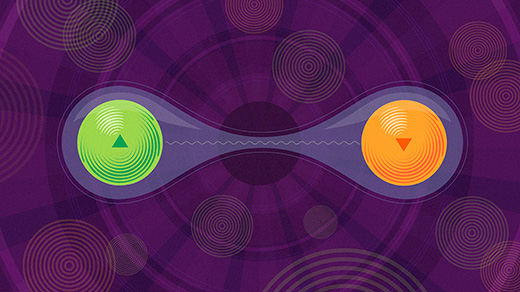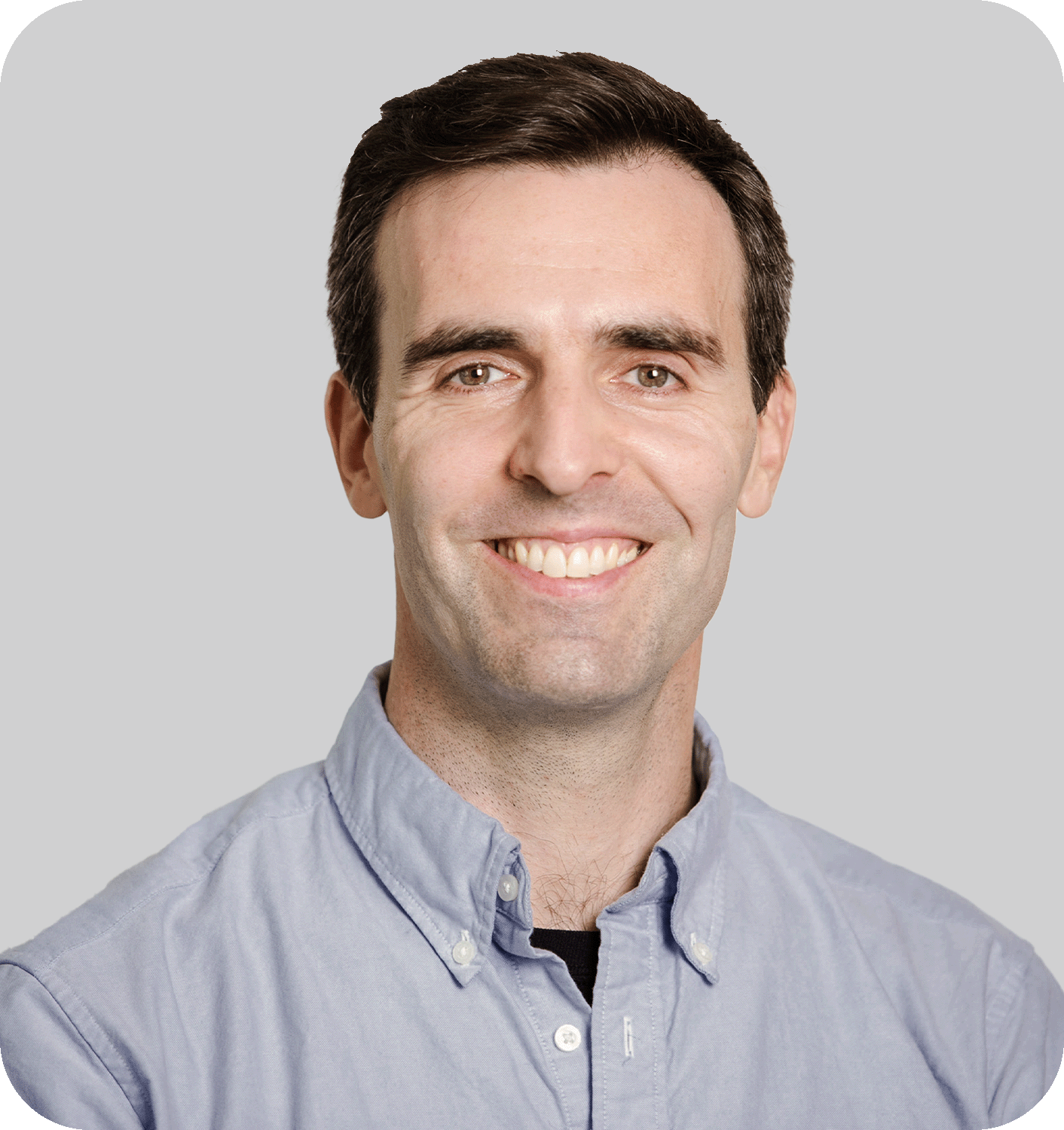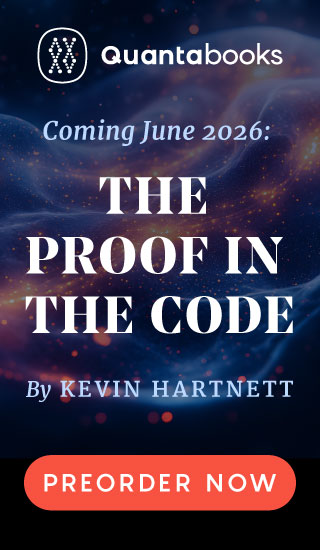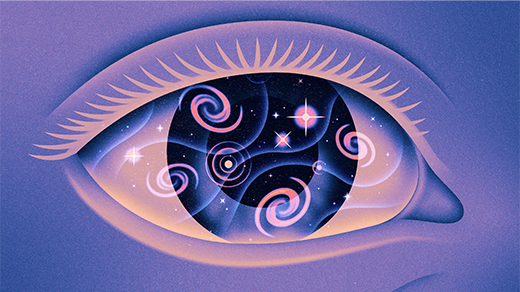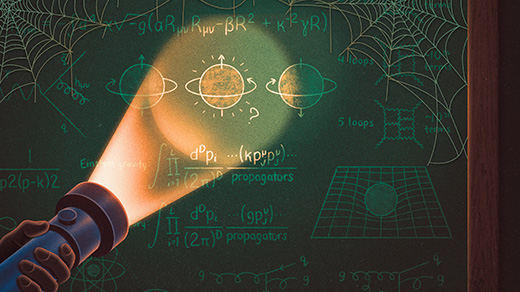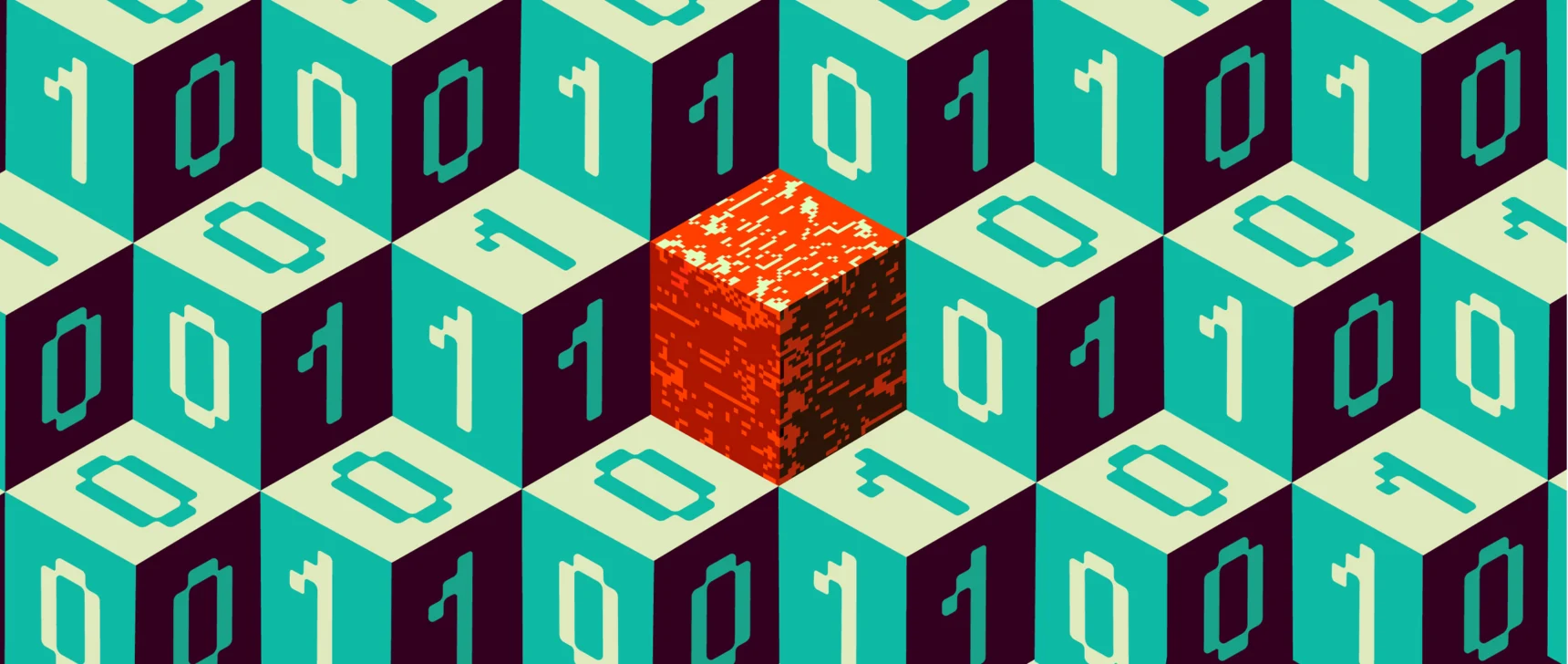‘It’s a Mess’: A Brain-Bending Trip to Quantum Theory’s 100th Birthday Party
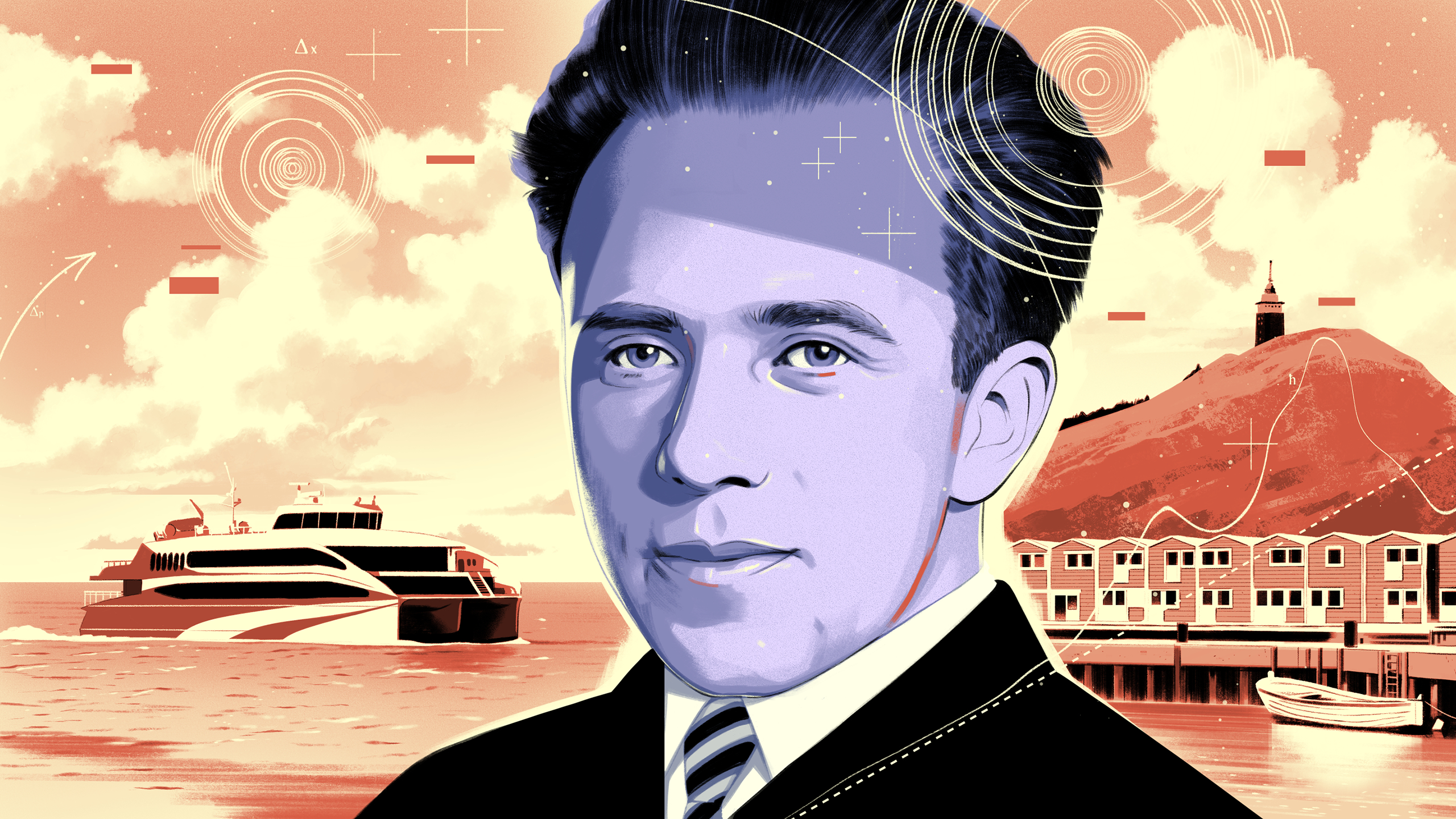
In the summer of 1925, a young Werner Heisenberg retreated to Helgoland in the North Sea and reemerged with the first full-fledged version of quantum mechanics. A century later, the theory’s meaning remains unsettled.
Señor Salme for Quanta Magazine
“Happy 100th birthday, quantum mechanics!” a physicist bellowed into a microphone one evening in June, and the cavernous banquet hall of Hamburg’s Hotel Atlantic erupted into cheers and applause. Some 300 quantum physicists had traveled from around the world to attend the opening reception of a six-day conference marking the centennial of the most successful theory in physics. The crowd included well-known pioneers of quantum computing and quantum cryptography, and four Nobel Prize winners.
“I feel like I’m at Woodstock,” Daniel Burgarth of the University of Erlangen-Nuremberg in Germany told me. “It’s my only chance to see them all in one place.”
One hundred years to the month had passed since a 23-year-old postdoc named Werner Heisenberg was driven by a case of hay fever to Helgoland, a barren, windswept island in the North Sea. There, Heisenberg completed a calculation that would become the heart of quantum mechanics, a radical new theory of the atomic and subatomic world.
The theory remains radical.
Before quantum mechanics hit the scene, “classical” physics theories dealt directly with the stuff of the world and its properties: the orbits of planets, say, and the speeds of pendulums. Quantum mechanics deals in something more abstract: possibilities. It predicts the chances that we’ll observe an atom doing this or that, or being here or there. It gives the impression that particles can engage in multiple possible behaviors at once, that they have no fixed reality. So physicists have spent the last century grappling with questions like: What is real? And where does our reality come from?
The morning after the banquet in Hamburg, the gathered physicists (and a handful of journalists) traveled by ferry to Helgoland to discuss where things stand a century after the theory’s birth.
Discussion began almost as soon as we boarded the boat. By the time I reached my seat, Časlav Brukner and Markus Arndt, both of the University of Vienna, were deep in conversation about whether the fabric of space and time follows the same quantum rules that particles do. Adán Cabello of the University of Seville soon joined in. I saw a passionate finger pointing into the air, and someone exclaimed, “What do you mean, what do I mean?”

A high-speed ferry took the conference-goers from Hamburg to Helgoland in the North Sea, a five-hour journey on a rather rough day.
Charlie Wood/Quanta Magazine
As the ferry left the shelter of the Elbe River and entered the rough waves of the North Sea, Cabello threw up his hands. “We are here happily celebrating 100 years,” he said, “but actually it’s a mess. We were given this theory, and we still don’t understand what it means.”
Suddenly feeling a wave of nausea, I excused myself from the philosophizing and sought fresh air on the ship’s second-floor deck.
Heisenberg in Helgoland
I clenched the railing with both hands and stared into a thick fog, vainly seeking the steady sensory input of a horizon as we pitched up and down in the swell. (The ferry operators canceled later crossings that day.) Eventually, to the relief of the many passengers with less-than-perfectly-steeled stomachs, the ferry pulled into the port of Helgoland.
We had reached a world apart. The German island has nearly 1,400 residents, whose modest homes are split between an Unterland at sea level and an Oberland perched on the rim of a grassy plateau, dotted with sheep and free-wheeling seabirds. It was in this divided land that the seed of quantum mechanics sprouted in Heisenberg’s mind.

The buildings of Helgoland’s Unterland stretch out below the plateau of the Oberland.
Charlie Wood/Quanta Magazine
For decades, clues had been mounting that matter and light defied common logic. In classical physics, locations, speeds and other properties of objects had always been free to take on any value, and consequently, changes always took place in a smooth, continuous way. But in 1900, measurements of light shining from hot objects led Max Planck to argue that matter must gain and lose energy only in discrete amounts, with the energy rising and falling in tiny hops. It was the first hint that the world was “quantized,” the namesake of quantum mechanics. Five years later, Albert Einstein made the case that light — which had always acted steadfastly like a continuous wave — also came in particle-like chunks of energy. And in 1913 Niels Bohr proposed that electrons orbit the atom only at certain fixed distances; when they gain or lose energy, they instantaneously “jump” between orbits. But nobody had yet managed to gather these curious facts into a coherent description.
Heisenberg, a protégé of Bohr, took daily walks and long swims on Helgoland as he mulled things over. Bohr’s model of the atom, he knew, wasn’t quite right. It predicted the correct frequencies of light emitted by hydrogen atoms but didn’t work for bigger, more complicated atoms.
So Heisenberg took a conceptual leap that still boggles minds today. At the conference, Bill Unruh, a renowned physicist with a beard that would make Santa Claus jealous, told me he simply cannot see how Heisenberg arrived at the calculation that he did, calling his route “a mystery.” One night over drinks, the astrophysicist Matt O’Dowd, host of the PBS Space Time YouTube channel, joked that perhaps the wilds of Helgoland hide some mushrooms with mind-opening effects. Nathalie de Leon of Princeton University noted in her talk that Heisenberg had reportedly used cocaine to alleviate his allergies.
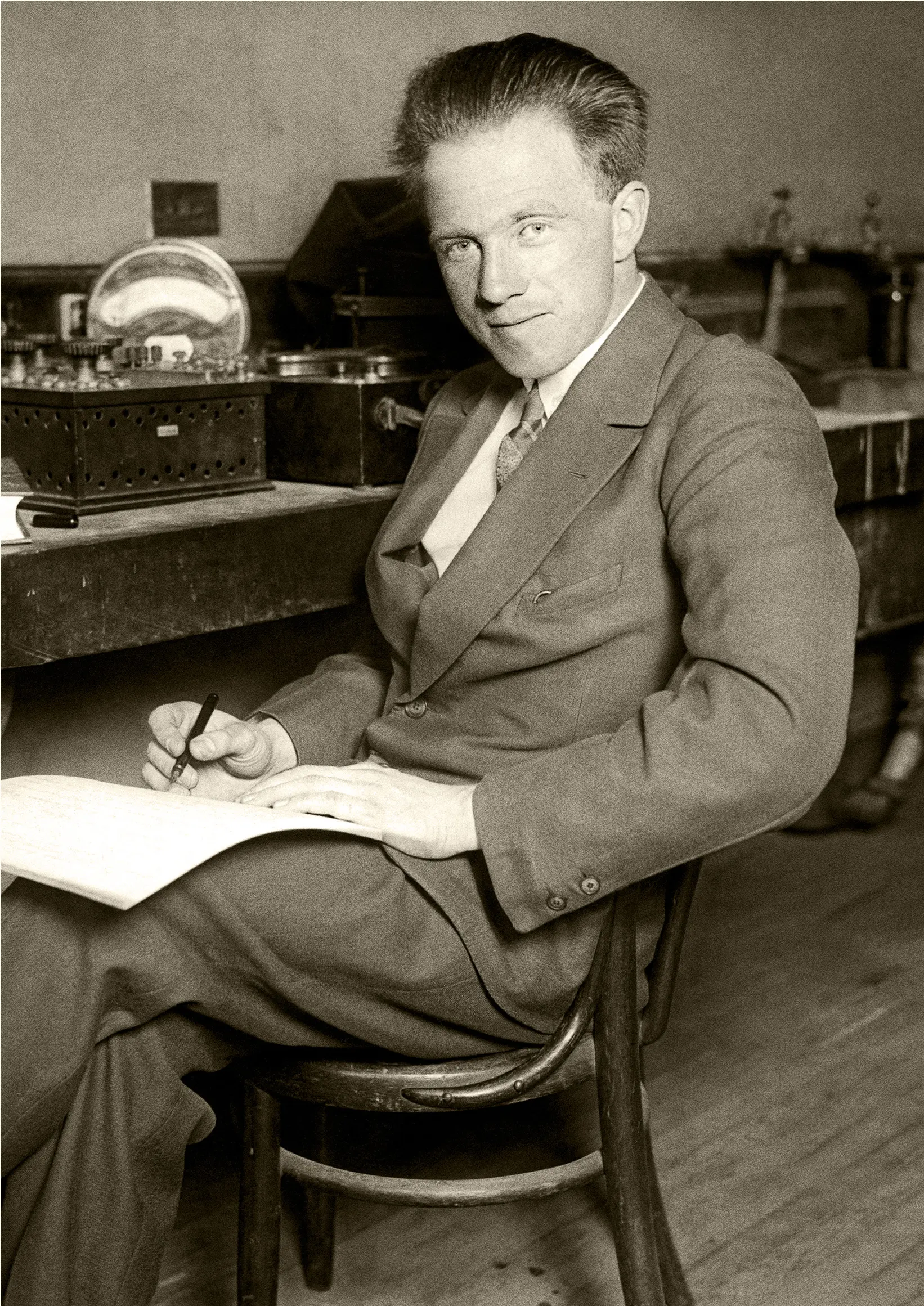
Werner Heisenberg gave up on trying to visualize the atom and focused only on the outcomes of experiments. This led him to the first formulation of quantum mechanics.
Alpha Historica/Alamy
Whatever sparked it, his insight triggered a seismic shift in physics. He relinquished the mental image of the atom as a little solar system with electrons orbiting on fixed paths. Such fine microscopic clockwork lay beyond the reach of direct experiment, he reasoned, so the theory shouldn’t refer to it directly either. In his new description, Heisenberg restricted himself only to properties measurable by machines far away from an atom — namely, the color and intensity of the light that it emits. After a long night of calculations, he found a way to remix arrays of numbers describing measurable attributes of light in a way that reproduced Bohr’s prediction of hydrogen’s glow. He did it without referencing the hydrogen atom or the movement of its putative parts. His observation-based framework was more abstract, and therefore more likely to work for other atoms too.
Decades later, Heisenberg wrote about how his eureka moment on Helgoland inspired a sunrise climb by the sea near the Unterland. I “felt almost giddy at the thought that I now had to probe this wealth of mathematical structures nature had so generously spread out before me,” he recalled.
By the fall, his colleagues had discerned something wonderful in his math. That October, Heisenberg’s fellow wunderkind and sometime rival, the 25-year-old Wolfgang Pauli, wrote that the work gave him “a new hope and a new enjoyment of life.” Max Born, a more senior physicist, realized that Heisenberg had unwittingly hit on the rules for multiplying grids of numbers called matrices — high mathematics in the 1920s. With matrices, the order in which you multiply things matters. For normal numbers, both 3 × 4 and 4 × 3 give 12. But for matrices, A × B usually gives something different than B × A. This “noncommutativity,” an exotic feature of Heisenberg’s Helgoland calculations, would become the heart of quantum mechanics.
In November, Born, Heisenberg and Pascual Jordan penned what history would deem the “three-man paper,” a fleshing-out of Heisenberg’s Helgoland work that detailed exactly how any quantum system — the hydrogen atom or another collection of quantum particles — would act. Quantum mechanics had entered the world.
But what did the matrices say about reality? Heisenberg grasped one surprising consequence in 1927, when he cooked up a thought experiment showing that you can exactly measure either an electron’s position or its momentum, but not both; there will always be some uncertainty in one property or the other. The insight is now known as the Heisenberg uncertainty principle. This limitation wasn’t a statement about experimental precision or creativity; rather, it was an inescapable mathematical truth. If quantum mechanics describes reality, then reality itself must be fundamentally set up in such a way that at times, for certain objects, certain properties cannot exist.
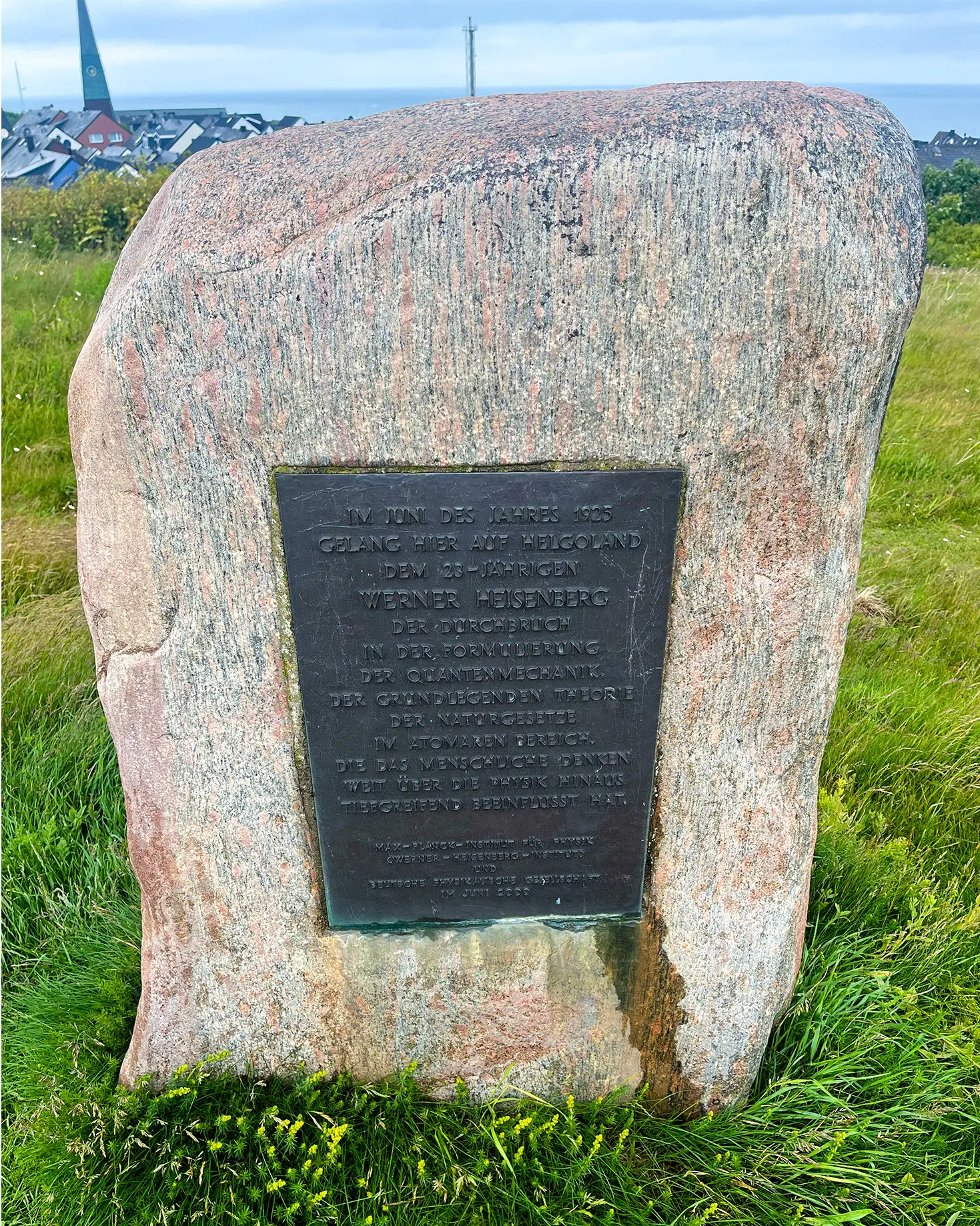
On Helgoland’s Oberland, a monument honors Heisenberg’s 1925 breakthrough.
Charlie Wood/Quanta Magazine
Erwin Schrödinger developed another version of quantum mechanics in 1926 that turned out to be equivalent to Heisenberg’s matrices. In Schrödinger’s version, a pointlike particle such as an electron is recast as a wave extending through space. An equation describes how the wave will change over time. Schrödinger hoped that the wave might literally describe an electron smeared out in space — a real object that could be visualized — but Born quickly realized that this dream was too simple to be true. Instead, Born showed that the wave in the Schrödinger equation represents not the electron’s present reality but rather its potential realities: possible positions of the electron. Peaks in the wave indicate where the particle is likely to be found.
By the early 1930s, it was becoming clear that quantum mechanics, in either the wave version or the matrix version, does not deal with particles in specific positions moving in specific directions. It predicts many possible future outcomes and says nothing about a singular, fixed reality. Do an experiment over and over, and the theory says only what percentage of the time you’ll measure one result versus another. It was a shocking retreat from what physicists were allowed to think about — one that Schrödinger and Einstein never accepted. “You are suddenly speaking of what we know about nature and no longer about what nature really does,” Heisenberg recalled Einstein telling him.
A century later, physicists still don’t feel completely at peace with it.
“It’s our most fundamental description of reality,” Matt Leifer, a physicist at Chapman University, told me over Zoom the week before the conference, but “it’s not a description of reality.”
The Problem With Measurement
No one doubts that quantum mechanics works, and works spectacularly. On Helgoland, researchers presented a parade of technological marvels that all depend on the quantum math of Heisenberg and Schrödinger. Jun Ye of the University of Colorado described atomic clocks that can keep time that’s accurate to the second for six and a half times the age of the universe, and the even more accurate “nuclear” clocks on the horizon. Mikhail Lukin of Harvard University showed footage of atoms dancing in elaborate patterns as they perform computations in a novel, quantum way. Many presentations touched on the wonders that such quantum computers can theoretically perform — calculations that are effectively impossible for any computer chip built from silicon transistors. These futuristic machines will derive their power from the ability of quantum objects to sustain multiple simultaneous possibilities.
But what these possibilities really are, and how they generate the apparently single concrete reality that we experience, is a profound puzzle physicists haven’t yet managed to solve.
The magic happens at the moment of measurement, and so the mystery is known as the measurement problem. This “measurement problem is a serious physics problem,” said Nicolas Gisin, a physicist from Constructor University, in his talk on Helgoland. “Without a resolution, quantum theory is not physics.”
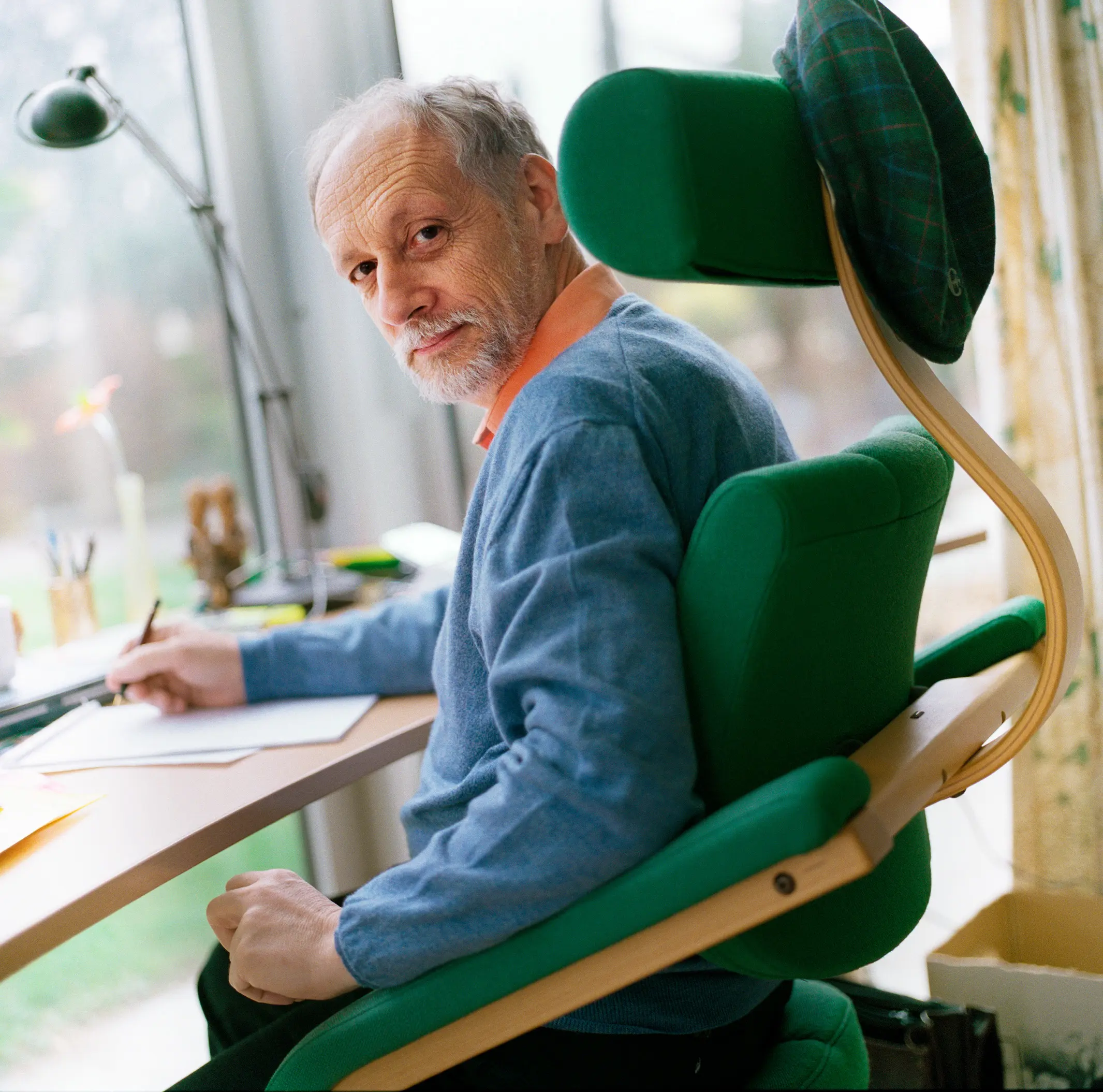
Nicolas Gisin, a physicist at Constructor University, thinks a wider variety of experiments beyond the typical Bell test will help physicists understand the nature of measurement.
Carole Parodi
Left to its own devices, a quantum object is best described by a quantum state, labeled ψ (the Greek letter psi). That state is a sort of mathematical summary of all the possible things that object could be doing — moving to the right, moving to the left, pointing up, pointing down, and so on. Schrödinger’s equation tells you how ψ changes from moment to moment.
When you measure the object, ψ “collapses,” meaning all but one of the possibilities go away. That remaining possibility, appearing at random from among the options, becomes the outcome of the measurement. Quantum mechanics predicts the likelihood of that outcome — ψ can tell you that you have a 22% chance of detecting a particle in a particular location, for instance. And if you run the experiment and make the measurement over and over, you’ll find the particle in that spot about 22 times out of 100. You just can’t predict the outcome in any single run of the experiment.
But this “orthodox” presentation of quantum mechanics raises profound questions. What is ψ, with all the possibilities it describes? Is it a physical thing that exists in the world? Or is it a mathematical representation of our incomplete knowledge of the future, something that exists only on our blackboards and in our minds? And when a measuring device enters the picture — itself made of quantum particles like everything else — why does it behave in this new, rather un-quantumlike way, mysteriously collapsing ψ into a single, classical outcome? While Heisenberg and Bohr felt deeply interested in the philosophy of their theory, they ultimately punted on these questions. Or at least, they felt perfectly content to give up on anything remotely resembling a classical world if ψ could do a better job. “The atoms or the elementary particles are not as real” as the phenomena of everyday life, Heisenberg wrote. “They form a world of potentialities or possibilities rather than one of things or facts.” As Bohr is said to have put it, “There is no quantum world. There is only an abstract quantum mechanical description.” The ideas Bohr, Heisenberg and the rest of their circle attached to the orthodox description of quantum mechanics is typically called the Copenhagen interpretation, since Bohr held court at his academic home, the University of Copenhagen in Denmark.
This way of thinking about the quantum world, the first one most physicists are exposed to in school, remains the most common. Ahead of the Helgoland conference, Nature surveyed more than 1,000 physicists and found that 36% subscribed to some version of the Copenhagen interpretation — making it more popular than any of its competitors.
But over the past century, many quantum physicists have grown increasingly dissatisfied with the agnostic, vague and sometimes self-contradictory pronouncements of the Copenhagenists. On no fewer than five separate occasions during the week on Helgoland, researchers shared with me a quote by the physicist E.T. Jaynes, who complained that quantum mechanics is “a peculiar mixture describing in part realities of Nature, in part incomplete human information about Nature — all scrambled up together by Heisenberg and Bohr into an omelet that nobody has seen how to unscramble.”
The Unmaking of Reality
Einstein was among the first to reject the Copenhagen omelet. He took the straightforward view that there was more to the quantum world than ψ — we just hadn’t discovered it yet. Future theories would describe additional “hidden variables,” he reasoned, and those entities would restore the classical notion of a world doing just one thing at every moment.
In 1935 he and two colleagues, Boris Podolsky and Nathan Rosen, proposed a thought experiment that they believed would expose quantum mechanics as an incomplete theory. The modern formulation of the “EPR experiment,” as it’s now called, starts with two quantum particles. These particles bounce off each other and fly to far-apart locations, where physicists (usually “Alice” and “Bob” in modern discussions) are each waiting to measure a pair of properties of each respective particle. Crucially, these must be noncommuting properties that quantum mechanics says can’t exist for one particle at the same time, such as position and momentum.
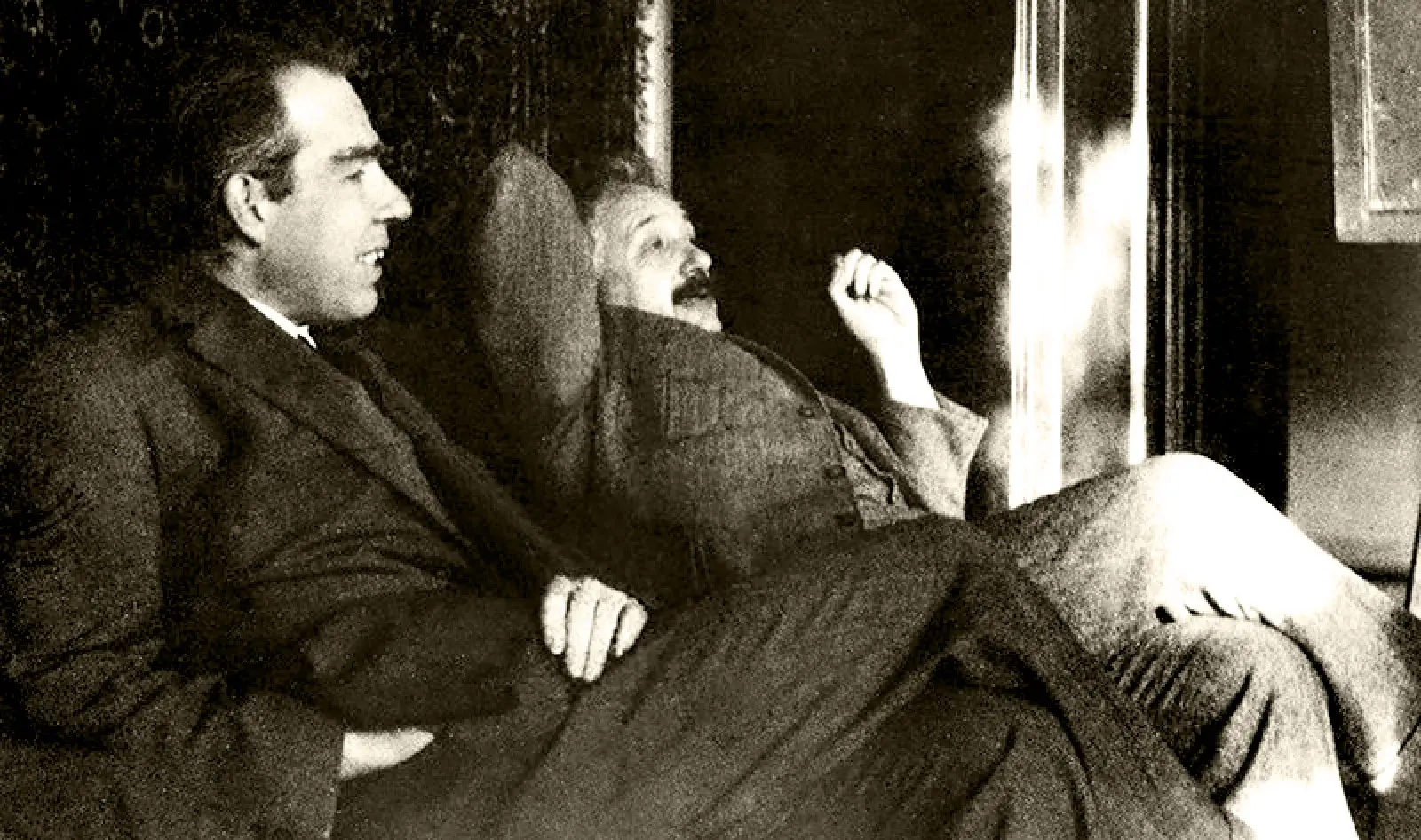
Niels Bohr (left) spent years sparring with Albert Einstein (right), who insisted that the world has more concrete properties than quantum mechanics suggests. Reality proved weirder than Einstein had believed.
Paul Ehrenfest
Nevertheless, Einstein, Podolsky and Rosen argued, both properties must exist for one particle after all. When the particles collide, each affects the course the other will take. If Alice measures the position of her particle, she can infer the exact position of Bob’s. Or she could measure her particle’s momentum and infer the exact momentum of Bob’s particle. And since the particles are too far apart for anything Alice does to affect Bob’s particle, Bob’s particle must have had those precise properties all along — contrary to what quantum mechanics would have us believe.
What Einstein’s crew hadn’t fully grasped was that the quantum state does not have to live in one place, in one object. In fact, what appear to us to be two independent objects can become linked by one shared quantum state. When this happens, the future of one particle comes to depend on the future of its partner. What Alice gets depends on what Bob gets even though they are too far apart for any physical influence to travel between them — something unthinkable to Einstein. The particles become entwined in a quintessential quantum phenomenon Schrödinger named “entanglement” in a paper responding to Einstein’s. A direct test of entanglement involving measurements of a stream of particle pairs was proposed by the Northern Irish physicist John Stewart Bell in 1964 and carried out by various experimentalists in the following decades, including two of the Nobel laureates present at the Helgoland conference. They proved that entanglement really happens. Our world is not the world Einstein expected.
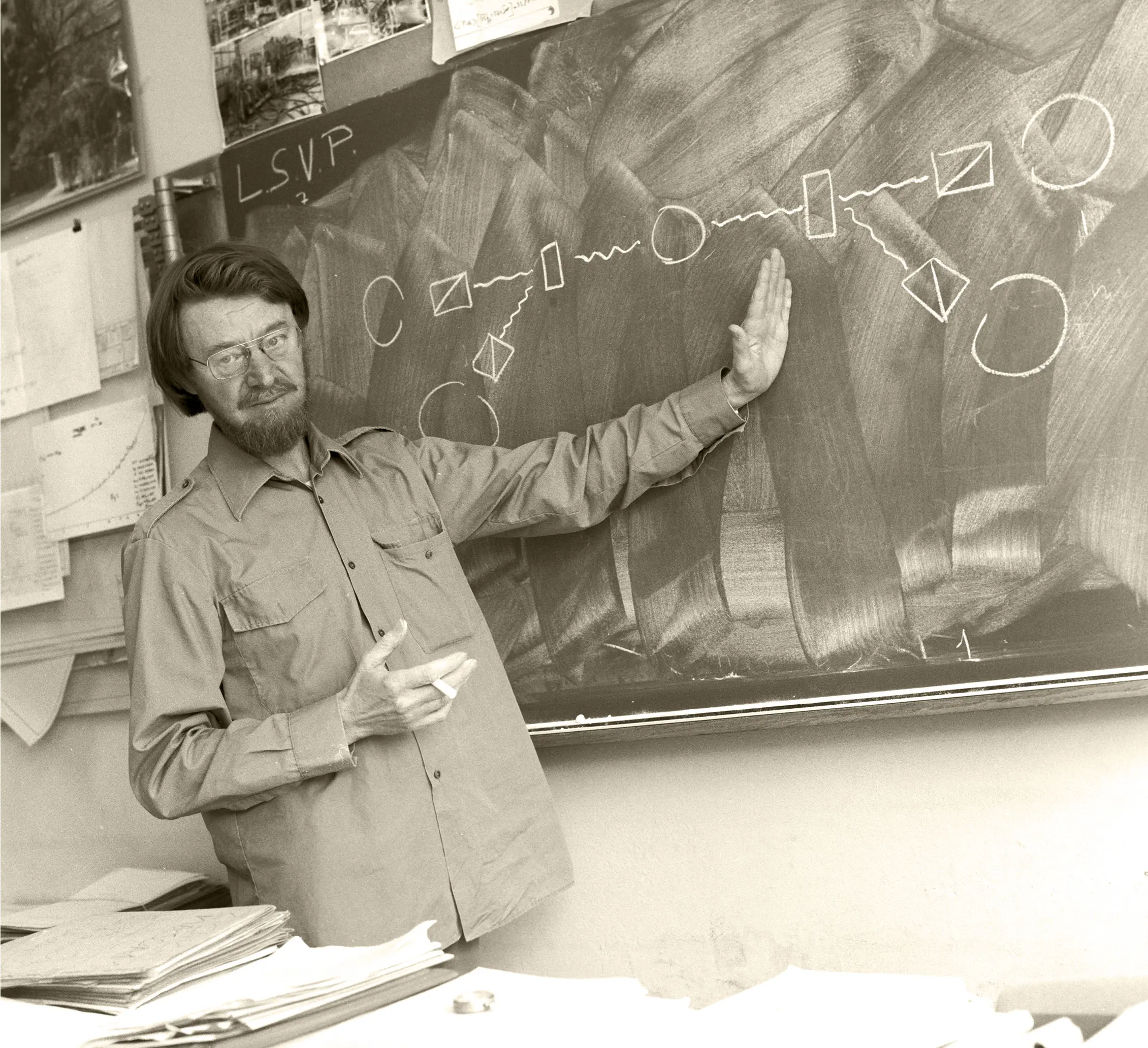
John Stewart Bell developed a sharp test of quantum mechanics. Later experiments upheld his quantum predictions, proving that the world either is nonlocal (meaning an event in one place can instantaneously affect another one far away) or lacks determined, “real” properties.
CERN
Thus, the most straightforward attempt to unscramble the omelet faltered. So long as one particle can’t reach out across space and instantaneously change another particle — a gross violation of Einstein’s theory of relativity that few physicists are willing to even consider — we live in a world where an individual particle simply may not have, say, a position. It has a range of possible future positions, as the quantum state says. Individual particles cannot have secret lives governed by hidden variables that ψ can’t see. The quantity ψ, whatever it may be, serves as a complete description of the world. And if ψ gives a complete accounting of nature, many post-Bell physicists came to assume, it must be a real physical entity.
And yet thinking of ψ as an object that exists in the world raises its own constellation of conceptual challenges. How does it collapse instantaneously, everywhere, all at once? Why does the ψ for an electron collapse when it interacts with a measurement machine but not when it interacts with another electron? And perhaps most vexingly, if the many possibilities of ψ are real in some sense, why do we only experience one reality?
“It’s just embarrassing that we don’t have a story we can tell people about what reality is,” exclaimed Carlton Caves, a physicist from the University of New Mexico, as he moderated a panel discussing quantum interpretations during our first day on the island. His palpable frustration was met with snaps of approval from the audience.
Those Who Know
Asked what aspects of the quantum world they consider “real,” physicists gave answers as varied as they were bewildering.
During a coffee break, John Preskill, a physicist at the California Institute of Technology who once helped Heisenberg operate a decrepit coffee machine in the basement of the Princeton physics department, expressed a mild preference for the infamous “many worlds” interpretation of quantum mechanics. Many-worlds asserts that all of ψ’s possibilities happen somewhere. When we see one pixel flash on a screen, recording the position of a photon, the world has actually split into many branches. In the other branches of reality (which exist simultaneously, invisible and undetectable from ours), other versions of us — who are just as real as we are — see different pixels flash, reflecting the other possible positions of the photon that were encoded in ψ. Not only is ψ everything, everything in ψ is.
Other physicists loathe the many-worlds interpretation, which they find ontologically excessive and psychologically unsettling. “Think of all sorts of terrible things that could happen right now. Let your imagination run wild,” said Lucien Hardy, a physicist at the Perimeter Institute for Theoretical Physics in Waterloo, Canada. “In the many worlds it definitely will happen.”
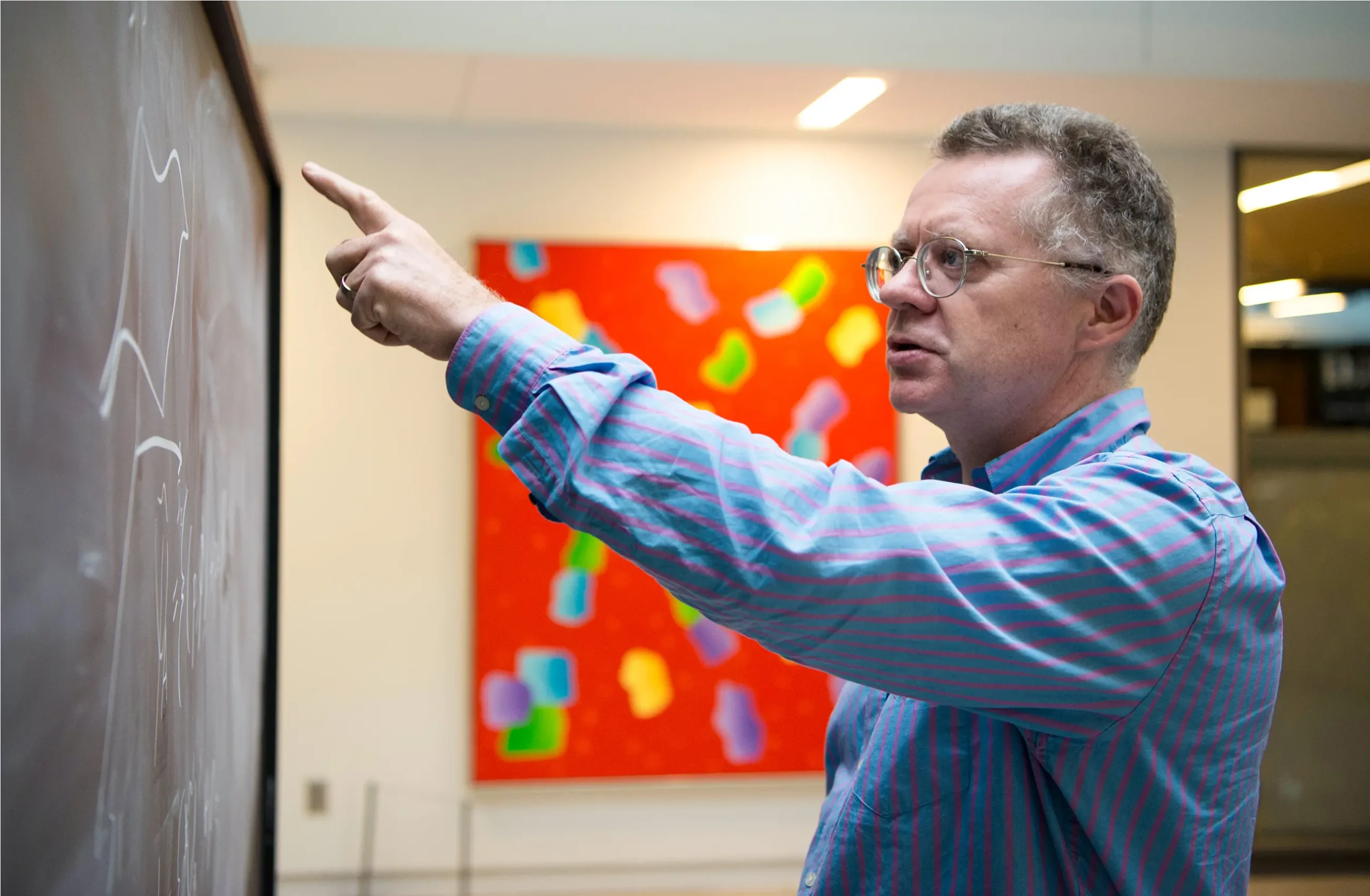
Lucien Hardy, a physicist at the Perimeter Institute, suspects that quantum theory will make more sense only after a union with Albert Einstein’s theory of gravity.
Gabriela Secara/Perimeter Institute
Interpretations of quantum mechanics are a bit like the quantum state itself. Possibilities proliferate wildly, forming a messy taxonomy. One afternoon, walking from the lecture hall back to the Unterland for lunch, Gilles Brassard, a long-haired computer scientist at the University of Montreal who co-invented a famous quantum method of cryptography, enthusiastically pitched me a new interpretation initially developed by his student collaborator, Paul Raymond-Robichaud. Like Einstein, Brassard feels repulsed by the way the particles in the Bell experiment seem to have firsthand awareness of each other despite being separated by, in principle, light-years of space. Instead, he explains, when Alice and Bob measure their particles, they could split into two versions of themselves, as in many-worlds. But instead of the whole universe splitting, only a small bubble around each physicist splits. Bassard and Raymond-Robichaud call it “parallel lives.” The two Alice bubbles and the two Bob bubbles expand outward at the speed of light; when they meet, the right Alice-Bob pairs can get together, compare notes, and see a peculiar sort of coordinated measurement like that predicted by Bell and required by quantum mechanics. In their version of quantum mechanics, the state’s possibilities are real but all contact is fully confined to local space.
“It’s exactly what Einstein wanted,” Brassard said. “Everything else I’ve seen is nonsense, especially Copenhagen.”
At one of the afternoon poster sessions, Ruven Hübner, a graduate student at the University of Bremen, grew tired of explaining his doctoral research, so he flipped over his poster and scribbled on the back in purple marker. The title of his impromptu poster read “Which Quantum Camp Are You,” below which a flowchart attempted to guide the reader through the tangled thicket of interpretations. As he began to walk me through the chart, however, Hübner cautioned me not to take the exercise too seriously, as a philosopher had just warned him that he wasn’t using most of the terminology correctly, and that some of the originators of the different interpretations might disagree with where he had sorted their proposals.
I found the physicists on Helgoland far easier to classify than their ideas. There were two types: those who believe they know what quantum mechanics means, and those who don’t.
Among the former, few are more certain than Chris Fuchs of the University of Massachusetts, Boston. He is one of the pioneers and chief champions of an interpretation called QBism, which once stood for Quantum Bayesianism but now has a linguistic identity of its own, kind of like KFC. Over lunch, Fuchs told me it was his life’s mission to end discussions like the ones I’d been having. “I view it as a public service to get rid of quantum foundations conferences,” he said. “Before I die, I would like to convince everyone of the answer.”
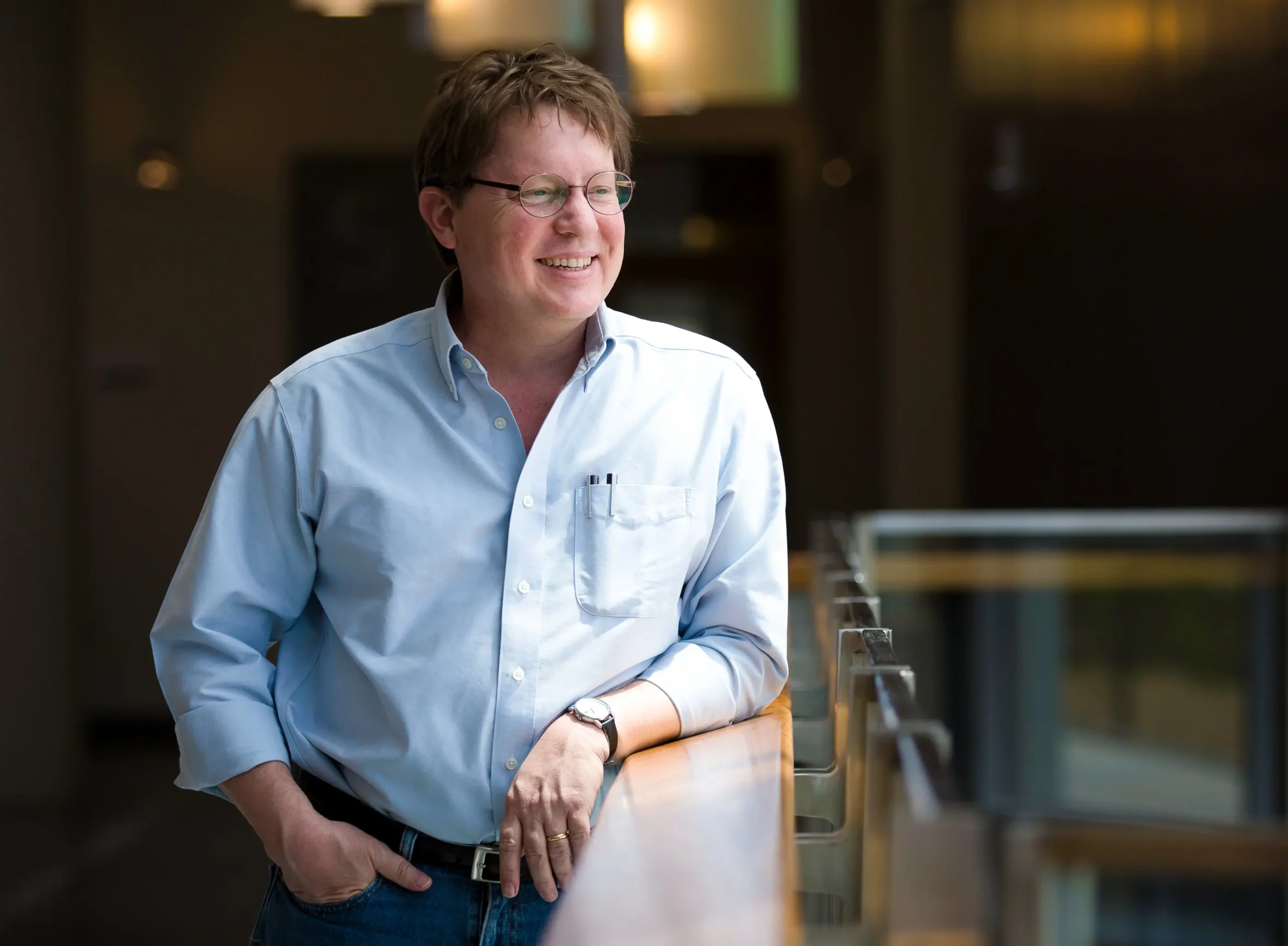
Chris Fuchs has pioneered QBism, an interpretation of quantum mechanics that characterizes the quantum state as information that an agent has about how their actions affect the world.
Katherine Taylor for Quanta Magazine
Fuchs takes a hard line on which quantum elements have a physical existence: next to none, and certainly not ψ.
In his view (and in the view of loosely related “epistemological” interpretations of quantum mechanics that deny ψ’s reality), the quantum state resembles your knowledge of the world before a presidential election. You can imagine multiple possible futures, one in which each candidate wins. If you’ve been following the polling, you might believe that some futures are more likely than others. When you learn which candidate won, your knowledge of the world changes instantaneously. Those alternative futures vanish.
QBism takes this philosophy to an extreme. The quantum state, the mathematical operations that represent measurements — everything gets interpreted in terms of information. “You keep going down this track and you’re like, ‘Holy shit, the whole world is going away; what are we left with?’” Fuchs said. “We’re left with the view that quantum theory is about making decisions.”
He likes to say that quantum mechanics is a user’s manual for the world, one that tells any “agent” — a term left strategically vague — how to place smart bets on what’s going to happen. “A quantum state is a catalog of my degrees of belief about the consequences of my actions,” Fuchs said.
This approach catches some flak for smacking of solipsism, since it seems as if the world exists only through the eyes of an agent. But Fuchs pushes back. He believes strongly in the existence of a real physical world, one that existed before there were agents to observe it. It’s just that we can’t make many meaningful statements about what that world is like until agents like ourselves arise to study it. “I’m in the world. I play a part in it. I can’t delete myself,” he said.
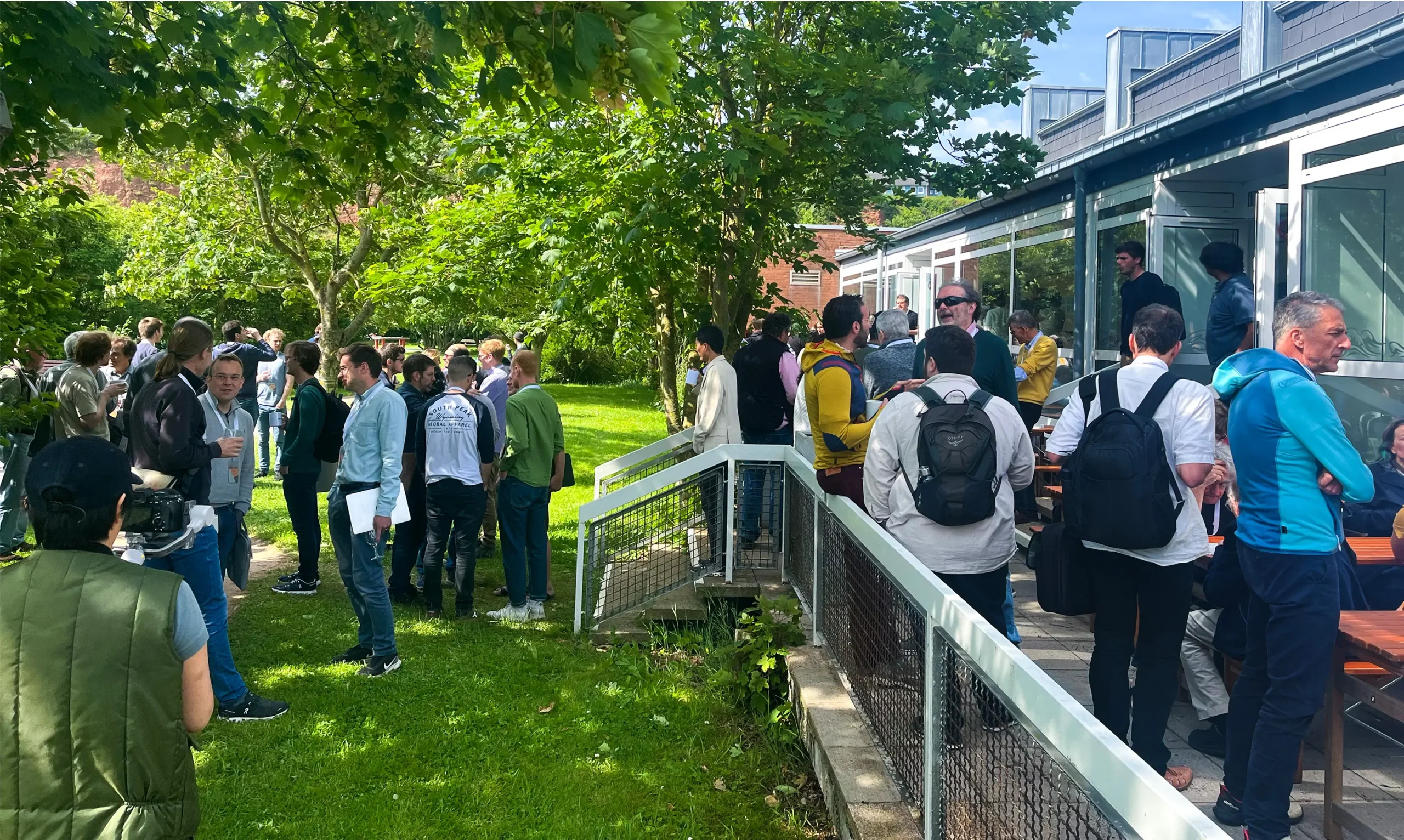
Physicists chatted outside the auditorium between lectures.
Charlie Wood/Quanta Magazine
In short, Fuchs proposes that the quantum omelet, much like a real omelet, can’t be fully unscrambled. The universe may exist “out there” in some sense, but it is the representation of it in our heads that we have direct access to. That representation is necessarily generated by our interactions with the world, so there is no meaningful way to extricate ourselves from the equations describing it. “How in the hell can you get outside of the universe and look back,” Fuchs said, using stiffer language than “hell.” “The thing you can do is be in it, push it around, and see what it does back to you.”
Fuchs’ take on quantum mechanics rhymes with that of Carlo Rovelli, an Italian theoretical physicist and another who thinks he knows. Rovelli agrees that the quantum state describes information — specifically, as he sees it, information about the relationships between objects, such as an electron and an agent observing that electron. He describes what the agent has learned from observation as reality.
“You’re very real. I think you have a blue shirt and you’re a tall guy and we’re talking,” Rovelli said to me as we waited in line to order pizza. “I have a lot of information about the reality of you.”
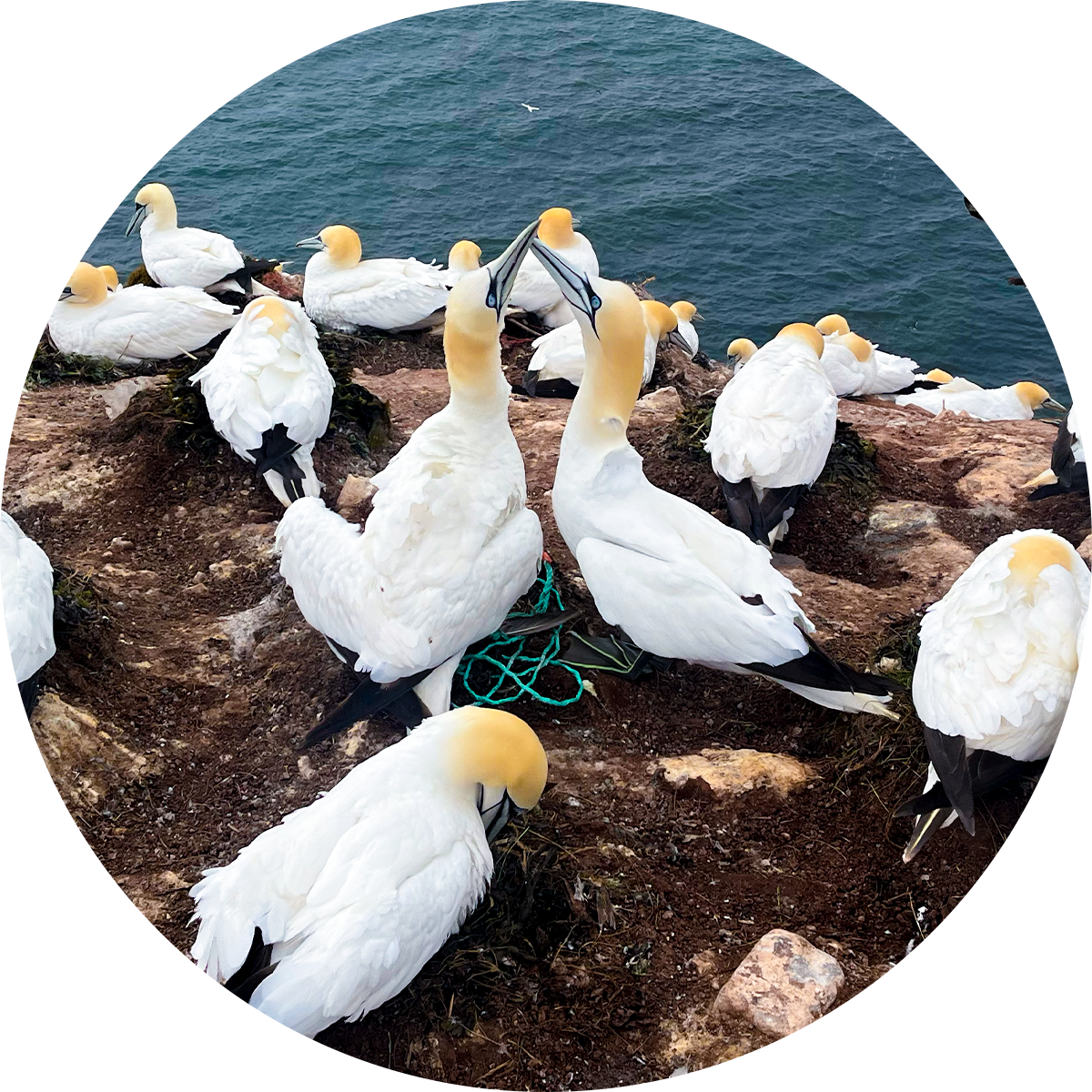
Northern gannets nest along the cliffs of Helgoland’s northwestern coast.
Charlie Wood/Quanta Magazine
But every interpretation has some implication that’s tough to swallow. The cringe-inducing conclusion of both QBism and Rovelli’s program, known as relational mechanics, is that in extreme conditions, one observer may have experiences that are logically irreconcilable with those of another observer. In other words, each observer is technically entitled to their own private reality, in a way that is uncomfortably reminiscent of many-worlds.
According to at least one person on Helgoland, quantum mechanics holds no mystery whatsoever and has been perfectly clear for 65 years. Anton Zeilinger, a physicist at the Institute for Quantum Optics and Quantum Information in Vienna who won the Nobel Prize for carrying out real-life Bell tests and other groundbreaking experiments, still follows the Copenhagen interpretation — specifically, the formulation laid out by Heisenberg in a 1960 letter. Zeilinger made it sound pretty simple. There is a world out there full of stuff that obeys rules, but we don’t have access to those rules. (“We can only rely on our knowledge. It’s the only thing we have,” he said.) The quantum state is the representation of that knowledge. To me his viewpoint — and perhaps by extension Heisenberg’s — sounded rather QBist. But Zeilinger insisted that it is Copenhagenist and politely declined to compare it with other proposals. “I defend my interpretation, and other people defend their interpretation,” he said.
Many others on the island, however, don’t defend any of the quantum camps on Hübner’s flowchart. Instead, they’re seeking something new.
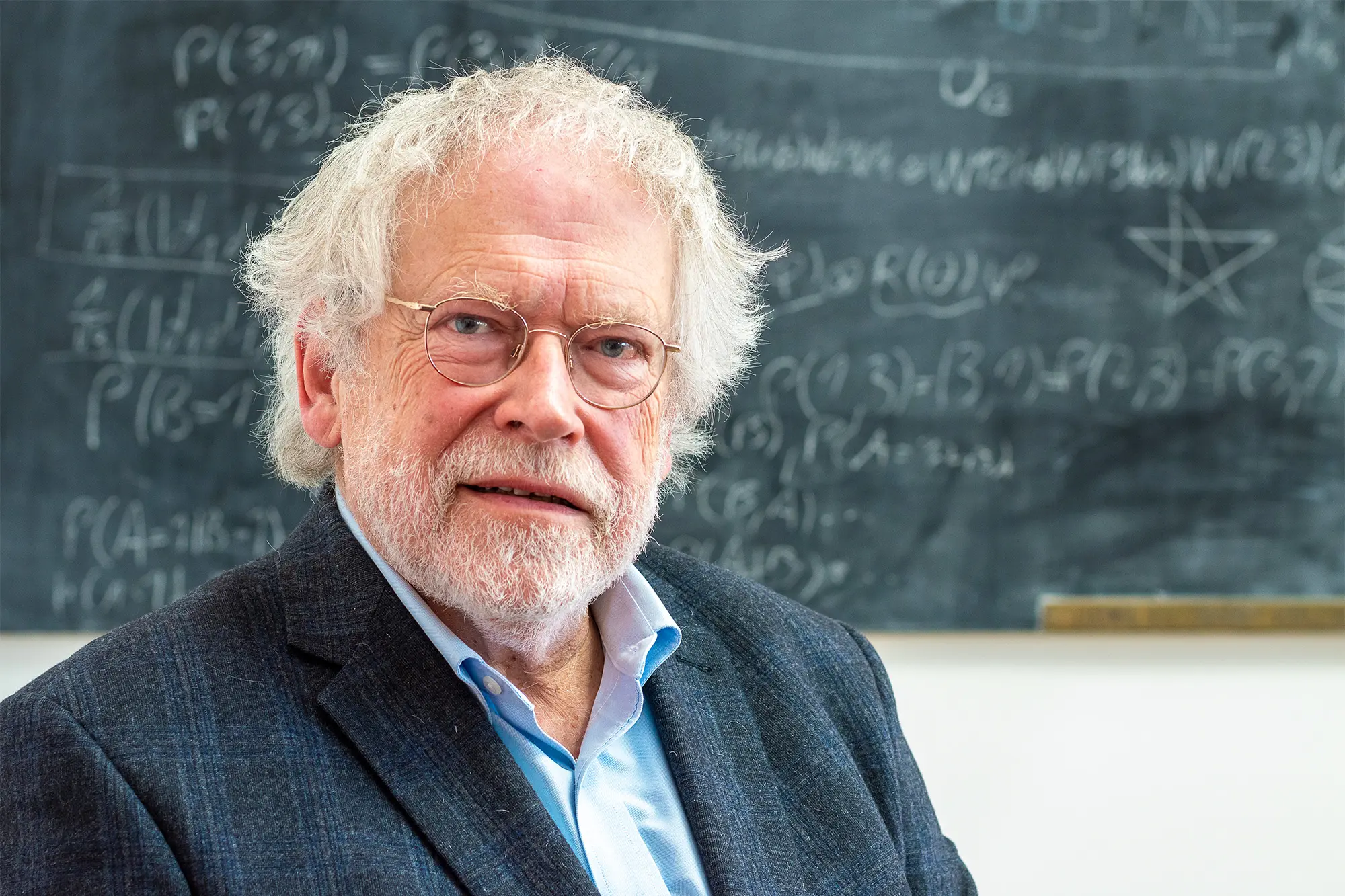
Anton Zeilinger shared the Nobel Prize for carrying out rigorous Bell experiments.
Jacqueline Godany
Those Who Don’t Know
The evening before Fuchs and I had lunch, he had given the first official physics talk of the conference, a lightning review of QBism and a report on some conjectures in number theory that QBist thinking had helped him make recent progress on. His closing words at the end of the question-and-answer session following the talk were, “QBism is here to stay. You won’t get rid of me.”
Then Gisin took the stage to discuss the nature of measurement and started his talk with an improvised dig at the QBist perspective. “Physics is all about extracting information about how nature does it. Nature,” Gisin said, pausing for emphasis and looking slowly out over the audience, “not agents.” The audience tittered. (Fuchs later told me they had carried their friendly sparring about the finer points of QBism to the local watering hole that night.)
I caught up with Gisin the next evening for dinner. Or at least that was the plan, but I joined him and his graduate students a few minutes after 6 p.m. The restaurant’s kitchen had just closed. He stood up for me, exchanging sharp words with the server. It was not the only testy encounter I witnessed between punctual islanders and the looser, often hungry physicists. “The island is stuck in the 1960s, as opposed to the rest of Germany, which has at least made it to the 1970s,” Burgarth, a native German, complained. “It’s cash only, no English, has crap food, and everything closes at 6. Although everyone is very nice.”
Gisin was kind enough to share with me both his seafood bouillabaisse and his vision for how to demystify measurement. He pointed out that the quantum state used in the Bell test — the white lab rat of quantum physics — is an exceedingly unusual state. Taken individually, Alice’s measurements and Bob’s measurements both appear completely patternless. Half the time, Alice measures one outcome, and half the time she measures a different outcome. It’s only when the two bring the lists together that they see Bell’s mysterious pattern of correlations emerge. There is information in pairs of particles, but not in individual ones.
But almost any other state will be different. Imagine a state where Alice gets one outcome 70% of the time and another outcome 30% of the time. She will see a pattern in her data. And she may discern a second pattern when she compares notes with Bob. In this case, their particles carry both “local” information — the pattern that Alice and Bob can discern on their own — and the “nonlocal” information that emerges only when they compare notes. When particles share both local and nonlocal information, how to measure them and extract that information is not so clear.
Gisin hopes that by fooling around with measurements of these more exotic states, physicists will come to better understand the role of measurement in general. He doesn’t know what the conventional wisdom will become when that happens, but he hopes that measurements will be seen to have one unique outcome (ruling out many-worlds), and that the world out there exists and can be described by rules that don’t depend on the actions of agents (ruling out QBism).
Helgoland’s anti-Fuchs was Gemma De les Coves, a soft-spoken physicist from Barcelona. “I do not understand quantum mechanics,” she declared. “I don’t know if the quantum state is a description of reality or a way to place bets. I would love to know if there are many worlds, and if I am splitting into many Gemmas as I speak.”
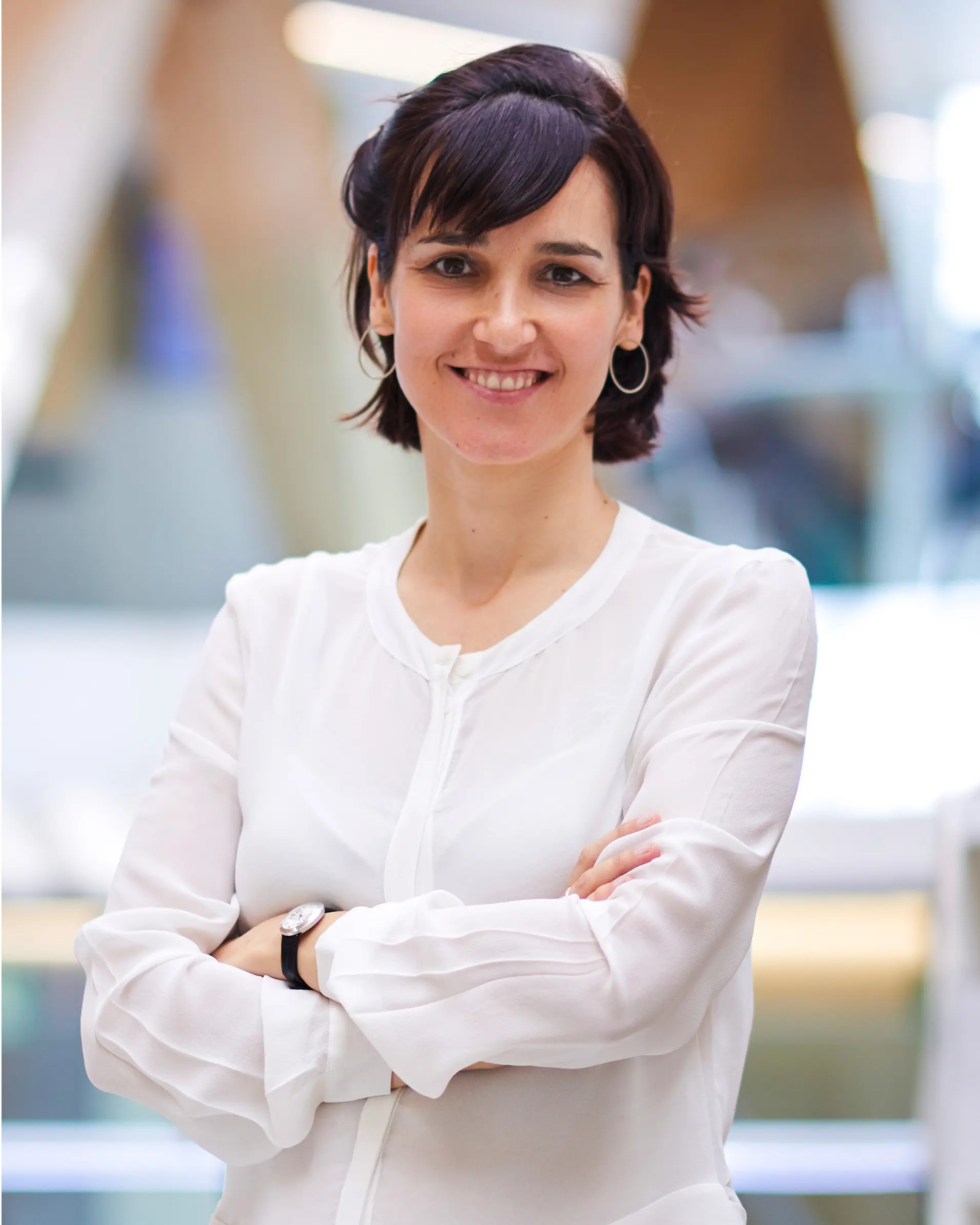
Gemma De les Coves, a physicist at Pompeu Fabra University in Barcelona, studies metaphysics and the meaning of quantum mechanics.
Miki Bosch
De les Coves began her career in physics studying the ways that information behaves in quantum systems. But she eventually grew dissatisfied with the clashing instructions for how the quantum state evolves: according to the Schrödinger equation at some times and by collapse at others. “You cannot swallow them,” she told me the next day. “They are a bunch of mathematical recipes, and they are inconsistent.”
Over the last few years, she has contributed to a research program that aspires to coax the quantum omelet to unscramble itself by infusing it with increasing doses of realism.
Last year, De les Coves and her collaborators studied a simple theory of a classical universe — one populated with objects in definite states, such as particles that are each in a specific spot. Then they put an agent in the theoretical universe and calculated how much the agent could learn about the particles according to classical physical laws. Surprisingly, they found that the agent couldn’t learn everything. As a necessary consequence of being trapped inside the universe, the agent would perceive certain particles as having a quantumlike state with multiple possible positions, even though from the God-like view outside the universe the particles do have real, specific positions. It’s only a simple model, but if our universe works the same way, then the simultaneous possibilities of ψ could be an artifact of our also being trapped inside our universe.
De les Coves’ work complements years of research from Robert Spekkens, a physicist at the Perimeter Institute. He has shown that in any world where agents are ignorant of details like exact particle positions (even if those positions do exist in a fixed, classical sense), that ignorance leads to a laundry list of allegedly quantum phenomena, such as the “teleportation” of a quantum state from one particle onto another. “If you have a classical model where you cannot know some things,” De les Coves said, “surprisingly, you can reproduce many things that appeared quantum.”
I chased down Spekkens as we were leaving the lecture hall on another afternoon. Since he’s been able to derive quantumlike effects from largely classical theories, does he think that reality might turn out to be classical after all, I asked — that Bell particles might have real, fixed properties before they get to Alice and Bob? He told me that someday he suspects physicists will look back at questions like that and realize they don’t make much sense, because a new way of thinking about reality will have subsumed both classical and quantum physics.
He brought up the omelet again and said that he’s been picking away at the knowledge side of it, deriving exactly how much of the canon of quantum weirdness can be chalked up to our ignorance. He’s found that quite a bit of ψ’s quantum strangeness — perhaps more than most people realize — can be explained if we assume it represents information as opposed to a physical entity. But it can’t all be explained that way. The remaining piece — the part we might call reality — he suspects will be largely about how one thing influences another.
“I think the essence of reality is causal connections,” Spekkens said.
As a loose metaphor, he suggested I picture a sort of black-and-white mosaic. I imagined one that portrayed a northern gannet of the sort I’d seen nesting on the cliffs during a walk around the Helgoland plateau. Based on our classical experience, we are accustomed to knowing the specific color of every tile. Perhaps, Spekkens suggested, that’s not essential. After all, if you flip every tile to the opposite color, you’ll still see the gannet’s silhouette. It’s the relationships between the tiles that matter, not their definite state.
Similarly, if physicists can fit both quantum and classical physics under some shared umbrella of realism, the specific states of the particles themselves might be meaningless compared to the way they can influence each other. “Maybe that’s sufficient to have a notion of reality,” he said, but “that’s the part where I know the least about how things are going to work out.”
Gravity to the Rescue?
Buffeted by dozens of competing accounts, I often felt as if we were little closer to understanding the nature of reality in 2025 than Heisenberg was in 1925. Some researchers also felt that a certain ennui has settled over the effort to interpret quantum mechanics. “What do we do when we’ve been working on a problem like this with some very great minds for the last hundred years?” asked Elise Crull, a philosopher and historian of physics at the City College of New York.

Elise Crull, a philosopher and historian of physics, was one of the conference’s keynote speakers. She spent the last few years studying the personal letters and other writings of the pioneers of quantum mechanics.
Elizabeth Gibney
One afternoon, as we sat down at the picnic tables outside the lecture hall to discuss the problem, Hardy, of the Perimeter Institute, echoed an idea I had heard throughout the week that might help physicists get unstuck: gravity.
Gravity is currently the only force in physics for which there is no quantum description. Instead, gravity is described by Einstein’s general theory of relativity. While quantum observations take place against a fixed backdrop of space and ψ evolves according to a steadily ticking metronome, general relativity describes how matter and energy contort space and time into a distorted shape, and how we experience the contours in that shape as gravity’s pull. What might it mean if space and time are also best captured by a ψ describing multiple contortions at once?
“General relativity is so conceptually strange,” Hardy said. “You might expect that when you bring quantum theory in you get something interesting, sort of a conceptual bonfire.”
Hardy has devoted his career to studying the meaning of quantum mechanics. In 2001, inspired by Fuchs’ ongoing mission to weave information theory into the heart of quantum mechanics, he managed to derive the theory from a handful of intuitive mathematical statements about probability. In the following years, he fixated on the question of what happens to the structure of space and time — the origin of gravity — when it merges with quantum mechanics. If space and time can bend in multiple possible ways at once, Hardy and others have found, one can imagine situations where it becomes impossible to say whether one event caused another event, or the reverse.
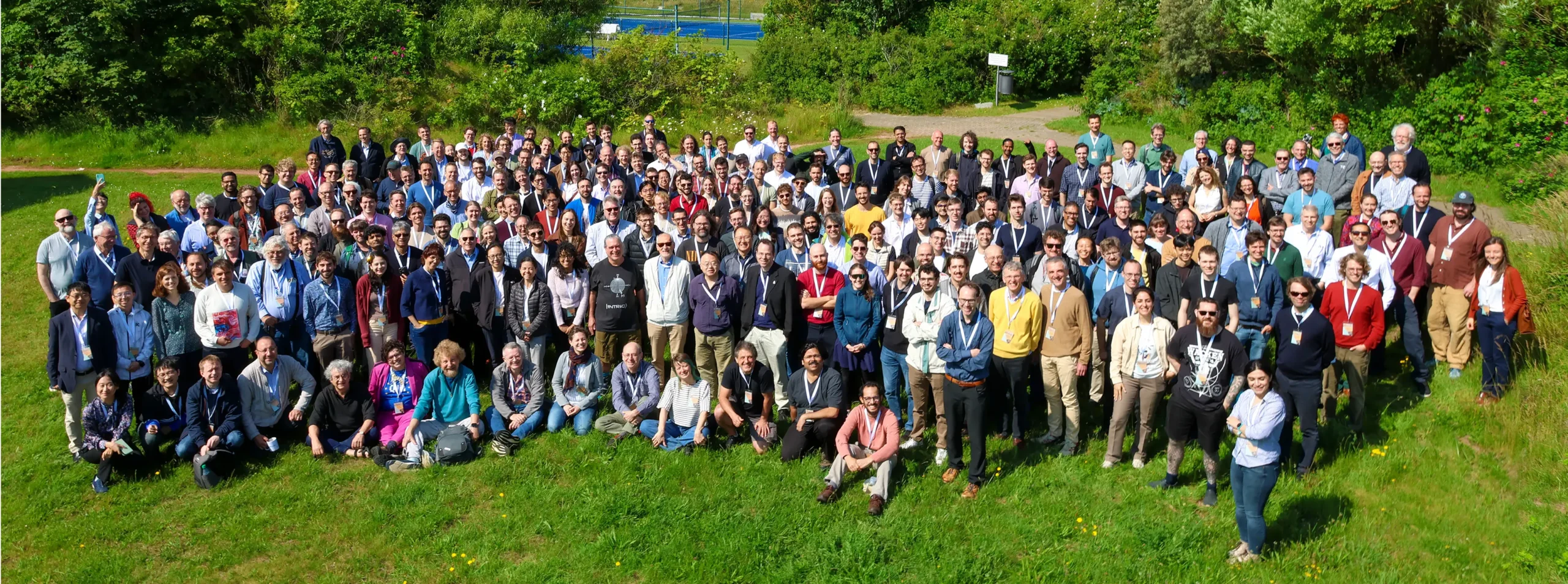
In June, some 300 physicists attended Helgoland 2025, a conference marking the centennial of quantum mechanics.
Bahar Gholipour
“That’s really problematic, because what does that even mean?” Hardy said. “Then I can’t talk about [the concept of] ‘now.’”
Taking cues from Einstein, Hardy has been developing a quantum version of the “equivalence principle,” the insight that helped Einstein tame gravity. Very roughly, Einstein’s idea was that the effects of gravity vanish from the point of view of a free-falling object (which is similar to how astronauts in orbit experience weightlessness). Similarly, Hardy is working with a particular point of view that makes the ambiguity of causality vanish in the quantum context.
He worries about where the math is leading him. As he fiddles around with ways of disambiguating causal order, he sometimes suspects he might be heading toward a formulation where the quantum state of space-time will be rendered entirely real and unambiguous. If that happens, all the possible futures described by ψ will become real too, in a manner uncomfortably reminiscent of the many-worlds take on ψ.
“My biggest fear is that on my tombstone it will say, ‘He made us believe in the many-worlds interpretation,’” Hardy said.
The Next Century
Brukner closed the conference with a joke. When he was growing up in the Balkans, his family’s housekeeper used to say dryly of life, “The first hundred years are hard. After that it should get much easier.” Perhaps, Brukner mused, the same might be true of quantum mechanics.
Our departure from Helgoland was certainly much easier than our arrival. Blue skies and calm waters made for a smooth ferry ride back to Hamburg. Again, the boat buzzed with conversation. Five days of lectures and debates had not diminished the group’s enthusiasm for seeking a deeper meaning from the theory. If anything, it seemed to have had the opposite effect.
“This was the first conference I’ve been to where people spoke openly and honestly about quantum mechanics missing something,” said Michel Devoret, a physicist studying quantum computing at Yale University. “Copenhagen was always a bit slippery about that.”
Heisenberg gave up on visualizing reality during his time on Helgoland. He and the rest of the Copenhagenists won their battle with Einstein, in that reality is indeed stranger and more subtle than Einstein could accept. But the attempt to build a stronger bridge between the concrete classical world and the surreal quantum world continues, and those toiling away at the task feel that a more satisfying and productive understanding of reality awaits. “We’re privileged to live at a time when the great prize of making sense of quantum theory is still there for the taking,” Spekkens said, “and any one of us could take it.”
